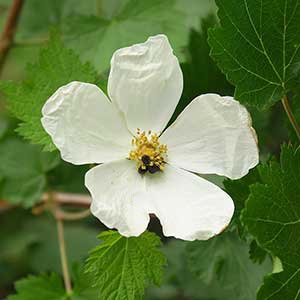Rubus bartonianus
Rubus vestitus
European blackberry
Leaves alternate, partially evergreen, 3- to 5-foliate;
stipules lanceolate, 5-10 mm. long;
leaflets ovate to rotund-ovate, acuminate, 5-10 cm. long, doubly serrate, green and glabrous above, paler and pubescent beneath.
Flowers numerous in flat-topped panicles, hairy and stipitate-glandular;
calyx white-woolly, the 5 lobes reflexed, lanceolate, acuminate, up to 1 cm. long;
petals 5, white, pinkish tinged, 10-15 mm. long;
stamens at least 75;
pistils numerous, styles glabrous.
Drupelets coherent, and with the receptacle forming a globular blackberry about 1.5 cm. thick.
Rubus bartonianus
Rubus vestitus
Occurring in scattered locations on both sides of the Cascades crest in Washington; British Columbia to Oregon, also reported from Idaho.
- Local floras:
BC,
OR,
WA
- Local Web sites:
Flora NW,
PNW Herbaria
WildflowerSearch
iNaturalist (observations)
USDA Plants Database
- LBJ Wildflower Center
- SEINet
- Plants of the World Online
- Encyclopedia of Life
- Wikipedia
- Google Image Search



